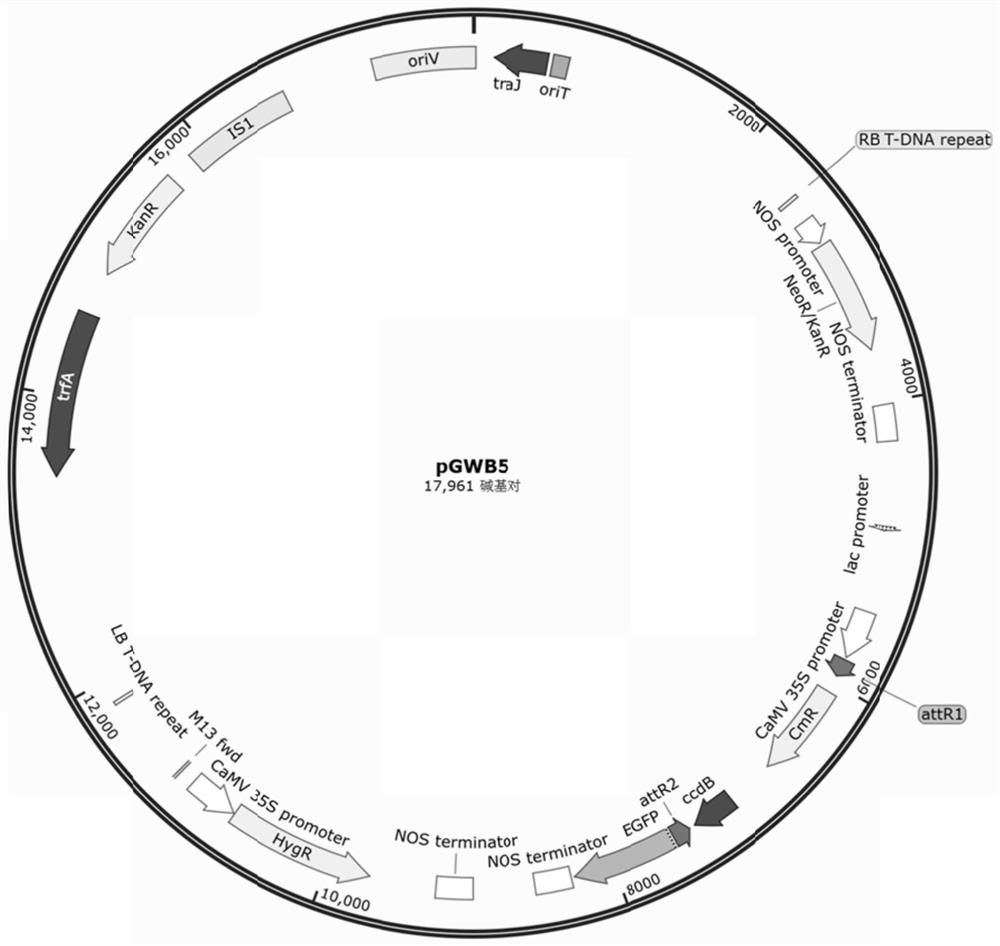Application of cspsi-n protein cspsi-n in cucumber photosynthetic system i reaction center in resistance to melon blight
A technology of photosynthetic system and reaction center, applied in the field of plant molecular biology and plant genetic engineering, can solve the problem that the N subunit protein of cucumber photosynthetic system I reaction center has not yet been discovered, and achieve the effect of wide application prospects
- Summary
- Abstract
- Description
- Claims
- Application Information
AI Technical Summary
Problems solved by technology
Method used
Image
Examples
Embodiment 1
[0092] Example 1 Construction of cucumber CsPSI-N gene overexpression vector
[0093] The cucumber CsPSI-N gene belongs to the N subunit protein gene of the photosynthetic system I reaction center. The full-length CDS of the cucumber CsPSI-N gene (SEQ ID NO. 2) was constructed into pGWB5 (the plasmid map of pGWB5 is as follows: figure 1 The specific position is between attR1 and attR2 after the 35S promoter (the ccdB gene was replaced by gene recombination exchange) to obtain an overexpression vector (pGWB5-CsPSI-N); the CDS non-conserved region of the cucumber CsPSI-N gene was The fragment of 200bp length (CDS108-307bp, SEQ ID NO.4) and its complementary fragment were constructed on pK7GWIW (pK7GWIW plasmid map such as figure 2 shown), the specific position is between the two attR1 and attR2 after the 35S promoter (the ccdB gene was replaced by gene recombination exchange), and the gene silencing vector (pK7GWIW-CsPSI-N) was obtained.
[0094] The amino acid sequence of cu...
Embodiment 2
[0102] Example 2 Construction of a transient overexpression / gene silencing cucumber cotyledon model
[0103] (1) The overexpression vector and the silencing vector in Example 1 were transformed into Agrobacterium GV3101, respectively, and cultured upside down on the corresponding resistant medium for 48 hours.
[0104] (2) Pick a single clone and add it to 4 mL of LB medium containing the corresponding antibiotics and rifampicin, shake the bacteria at 28° C. and 180 rpm for 24 h.
[0105] (3) Add in fresh LB medium containing corresponding antibiotics and rifampicin at a ratio of 1:100, shake the bacteria at 28°C and 180 rpm until the OD600 value is about 3.0.
[0106] (4) The cells were collected by centrifugation at 3000 rpm for 5 minutes, and the cells were collected with a suspension (10 mM MES, 10 mM MgCl) 2 ) to resuspend the cells, adjust the OD600 value to about 0.4, and add 200 mM acetosyringone.
[0107] (5) Stand at room temperature for 3h.
[0108] (6) Use a syr...
Embodiment 3
[0121] Example 3 Disease resistance experiment of cucumber cotyledons
[0122] For the cucumber cotyledon model with transient overexpression of CsPSI-N, the cucumber cotyledon model with CsPSI-N gene silencing, and the wild-type cucumber cotyledon successfully constructed in Example 2, the injected cucumber seedlings were cultured in the dark for 12 hours and then incubated in the light at 22°C for 3 days. Days later, the cotyledons of the cucumbers were isolated and inoculated with Phytophthora cucurbita, and then the cotyledons of the cucumbers were cultured in a Petri dish at 28°C for 24h in the dark.
[0123] The resistance function of the target gene to the disease was judged according to the size of the isolated cotyledon of cucumber with different treatments. The results are shown in the appendix. Figure 5 shown.
[0124] The results showed that transient overexpression of CsPSI-N gene (pGWB5-CsPSI-N) in cucumber cotyledons could significantly enhance the resistance ...
PUM
 Login to View More
Login to View More Abstract
Description
Claims
Application Information
 Login to View More
Login to View More - R&D
- Intellectual Property
- Life Sciences
- Materials
- Tech Scout
- Unparalleled Data Quality
- Higher Quality Content
- 60% Fewer Hallucinations
Browse by: Latest US Patents, China's latest patents, Technical Efficacy Thesaurus, Application Domain, Technology Topic, Popular Technical Reports.
© 2025 PatSnap. All rights reserved.Legal|Privacy policy|Modern Slavery Act Transparency Statement|Sitemap|About US| Contact US: help@patsnap.com



